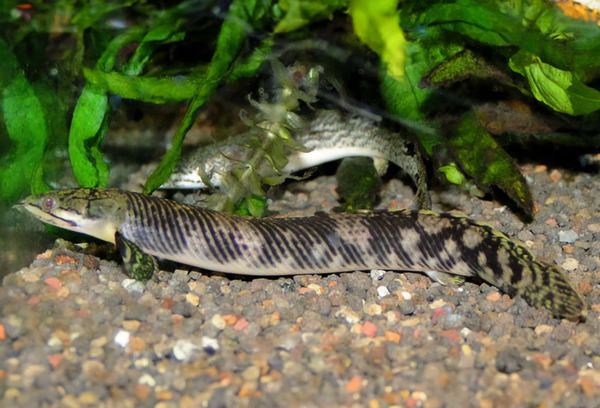Dinosaur Bichirs (Polypterus spp.) are carnivorous, opportunistic predators with strong nocturnal feeding instincts. Their diet consists mainly of live prey, frozen foods, and protein-rich alternatives. Understanding their natural feeding habits and dietary requirements is crucial for keeping them healthy and thriving in captivity.

In their native African freshwater habitats, Dinosaur Bichirs are bottom-dwelling ambush predators. Their diet includes:
Small Fish – Juvenile fish, slow-moving species
Insects & Larvae – Aquatic insects, beetles, mosquito larvae
Crustaceans – Shrimp, crabs, small crayfish
Worms – Earthworms, bloodworms, blackworms
Amphibians – Small frogs, tadpoles
Carrion – Scavenging on dead fish or decaying organic matter
They rely on their keen sense of smell rather than eyesight to locate food, often foraging in murky waters at night.
A balanced, protein-rich diet is essential for growth, health, and longevity. Here’s a feeding chart for different food types:
| Food Type | Examples | Recommended Frequency | Notes |
|---|---|---|---|
| Live Foods | Guppies, ghost shrimp, earthworms, mealworms | 2-3 times per week | Stimulates natural hunting behavior |
| Frozen Foods | Bloodworms, brine shrimp, mysis shrimp, silversides | 4-5 times per week | High in nutrients; prevent food boredom |
| Pellets & Sinking Carnivore Sticks | Hikari Carnivore Pellets, Massivore Delite, Arowana Sticks | Daily | Ensures balanced nutrition |
| Meaty Foods | Chopped tilapia, shrimp, squid | 2-3 times per week | Avoid fatty meats like beef or chicken |
| Gel Foods | Repashy “Grub Pie,” DIY seafood mixes | Occasional | Enhances variety in diet |
| Feeder Fish (Occasional) | Guppies, mollies, goldfish (quarantined) | Rarely (1-2 times per month) | Risk of parasites; must be quarantined |
⚠ Avoid feeding:
❌ Goldfish & Rosy Red Minnows – High in thiaminase, which can cause vitamin B1 deficiency
❌ Processed Human Food – Spices, fats, and preservatives are harmful
❌ Overfeeding – Leads to obesity, fatty liver disease
Swallowing Whole: Bichirs lack true teeth but have powerful jaws for gripping and swallowing prey whole.
Nocturnal Feeders: More active during the evening, so feeding at dusk or night is ideal.
Slow Eaters: Unlike aggressive predators, Bichirs take their time chewing and swallowing.
Hunting Instincts: Live foods trigger their ambush-style hunting, making them more engaged.
Juveniles (Under 1 Year) – 2-3 small meals per day for rapid growth
Sub-Adults (1-2 Years) – 1-2 meals per day
Adults (2+ Years) – Once per day or every other day
Pro Tip: Bichirs can go several days without eating, but consistency is key to maintaining optimal health!
✅ Boost Growth: High-protein foods like silversides, worms, and shrimp
✅ Enhance Coloration: Foods rich in astaxanthin (krill, shrimp)
✅ Increase Longevity: A balanced diet of pellets, fresh meat, and occasional live food
✅ Stimulate Hunting: Release live ghost shrimp or worms for natural predatory behavior
By feeding a nutrient-rich, varied diet, your prehistoric predator will remain healthy, active, and vibrant for years to come!
What do you feed your Bichir? Let’s discuss below!
animal tags: Polypteridae
We created this article in conjunction with AI technology, then made sure it was fact-checked and edited by a Animals Top editor.